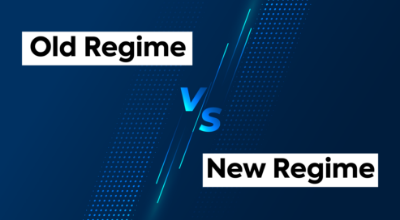With the introduction of new tax regime for individuals in 2020, the govt. gave an option to choose between the old tax regime and the new tax regime. However, the new regime got its real glow when the government introduced various incentives in the 2023 Budget to encourage the adoption of the new regime.
These changes hint that the government is encouraging taxpayers to transition to the new regime and eventually phase out the old one. Currently, the new regime is now the default tax regime, but the old tax regime will continue to exist.
How is the new regime different from the old regime, let us understand:
- Under the old regime, taxpayers can claim substantial deductions, including those specified in Section 80C, Section 80D, and Section 80TTA of the Income Tax Act. Conversely, individuals choosing the new regime can enjoy reduced tax rates depending on their income bracket, without as many deductions available.
- Different tax rates:
Income Slab | Old Tax Regime | New tax Regime | New Tax Regime |
(until 31st March 2023) | (From 1st April 2023) | ||
₹0 - ₹2,50,000 | - | - | - |
₹2,50,000 - ₹3,00,000 | 5% | 5% | - |
₹3,00,000 - ₹5,00,000 | 5% | 5% | 5% |
₹5,00,000 - ₹6,00,000 | 20% | 10% | 5% |
₹6,00,000 - ₹7,50,000 | 20% | 10% | 10% |
₹7,50,000 - ₹9,00,000 | 20% | 15% | 10% |
₹9,00,000 - ₹10,00,000 | 20% | 15% | 15% |
₹10,00,000 - ₹12,00,000 | 30% | 20% | 15% |
₹12,00,000 - ₹12,50,000 | 30% | 20% | 20% |
₹12,50,000 - ₹15,00,000 | 30% | 25% | 20% |
>₹15,00,000 | 30% | 30% | 30% |
- Higher Tax Rebate Limit: Full tax rebate on an income up to ₹7 lakhs has been introduced. Whereas this threshold is ₹5 lakhs under the old tax regime. This means that taxpayers with an income of up to ₹7 lakhs will not have to pay any tax at all under the new tax regime!
Difference Between Old Vs New Tax Regime: Which is Better?
The decision to switch to the new or remain in the old tax regime or which regime is better for you shall be based on the tax savings deductions and exemptions you are eligible for in the old tax regime. To make your decision making easier, below is a table capturing breakeven point for various income levels for a salaried individual below 60 years of age. This can be used to determine which regime to choose.
What deductions and exemptions are allowed under the new tax regime?
Here is a comparison between the deductions and exemptions available under the new and the old tax regime:
Sr. No. | Particulars | Old Tax Regime | New Tax Regime |
| |
1 | Income level for rebate eligibility | ₹ 5 lakhs | ₹ 7 lakhs | ||
2 | Standard Deduction | 50000 | 50000 | ||
3 | Effective Tax-Free Salary income | ₹ 5.5 lakhs | ₹ 7.5 lakhs | ||
4 | Rebate u/s 87A | 12500 | 25000 | ||
5 | HRA Exemption | ✓ | X | ||
6 | Leave Travel Allowance (LTA) | ✓ | X | ||
7 | Other allowances including food allowance of Rs 50/meal subject to 2 meals a day | ✓ | X | ||
8 | Standard Deduction (Rs 50,000) | ✓ | ✓ | ||
9 | Entertainment Allowance and Professional Tax | ✓ | X | ||
10 | Perquisites for official purposes | ✓ | ✓ | ||
11 | Interest on Home Loan u/s 24b on: Self-occupied or vacant property | ✓ | X | ||
12 | Interest on Home Loan u/s 24b on: Let-out property | ✓ | ✓ | ||
13 | Deduction u/s 80C (EPF | LIC | ELSS | PPF | FD | Children's tuition fee etc) | ✓ | X | ||
14 | Employee's (own) contribution to NPS | ✓ | X | ||
15 | Employer's contribution to NPS | ✓ | ✓ | ||
16 | Medical insurance premium - 80D | ✓ | X | ||
17 | Disabled Individual - 80U | ✓ | X | ||
18 | Interest on education loan - 80E | ✓ | X | ||
19 | Interest on Electric vehicle loan - 80EEB | ✓ | X | ||
20 | Donation to Political party/trust etc - 80G | ✓ | X | ||
21 | Savings Bank Interest u/s 80TTA and 80TTB | ✓ | X | ||
22 | Other Chapter VI-A deductions | ✓ | X | ||
23 | All contributions to Agniveer Corpus Fund - 80CCH | ✓ | ✓ | ||
24 | Deduction on Family Pension Income | ✓ | ✓ | ||
25 | Gifts upto Rs 50,000 | ✓ | ✓ | ||
26 | Exemption on voluntary retirement 10(10C) | ✓ | ✓ | ||
27 | Exemption on gratuity u/s 10(10) | ✓ | ✓ | ||
28 | Exemption on Leave encashment u/s 10(10AA) | ✓ | ✓ | ||
29 | Conveyance Allowance | ✓ | ✓ |
To understand more about such interesting concepts, stay tuned.
Until next time !!!


